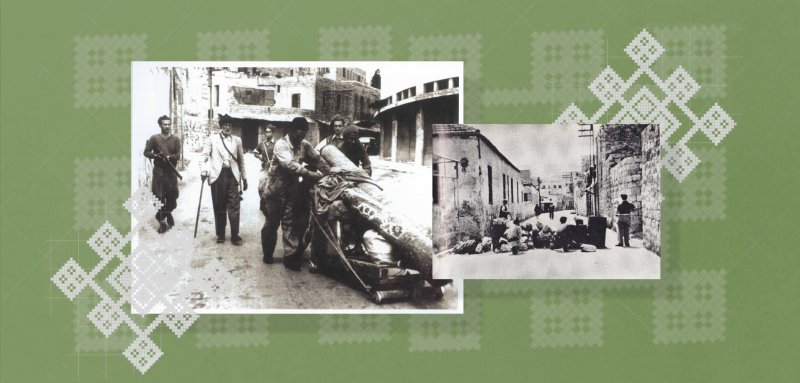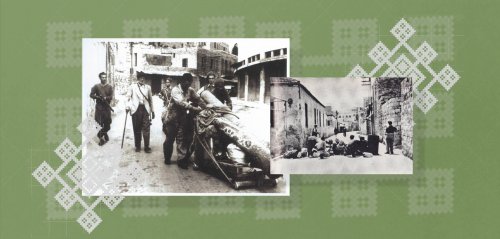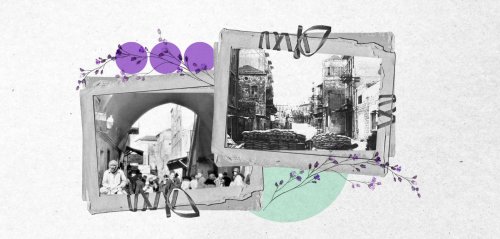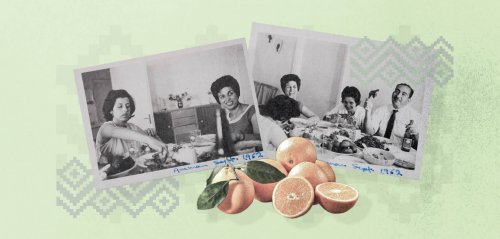This article comes as part of our commemoration of the 76th anniversary of the Nakba, a collection of personal and collective archives from Nakba survivors. This year, we shed light on archives that have been obscured by time or that have lived on in the hearts of their owners, their children, and their grandchildren. We shed light on them as we lose the original souls who lived through the Nakba. Much of these stories exist due to their passing onto the next generations, who continue to honor their family and ancestors by preserving and sharing their tales and experiences as if it were one continuous narrative.
Read in English here and in Arabic here.
A photo of Tamer Salah Abu Mousa, a student at Al-Azhar University in Gaza, defending his master's thesis in psychology before the graduate studies committee, moved me. It spoke of the determination to learn and achieve, despite the harsh conditions that Palestinians in Gaza, and beyond, are experiencing.
The scene did not take place on the university campus, which was annihilated by the Israeli war machine as part of its campaign to obliterate Palestinian educational, cultural, intellectual, heritage, and humanitarian institutions in the belief that this would wipe the Palestinian people.
This master's thesis defense took place in a tent that, for a moment, turned into a university. Does this not demonstrate unprecedented creativity and resilience?
This image, which I initially came across on Facebook, showed me that the lack of walls and a roof does not necessarily mean the absence of thought, creativity, and production. This thought stirred my emotions and thoughts more than any piece of art of music had ever.
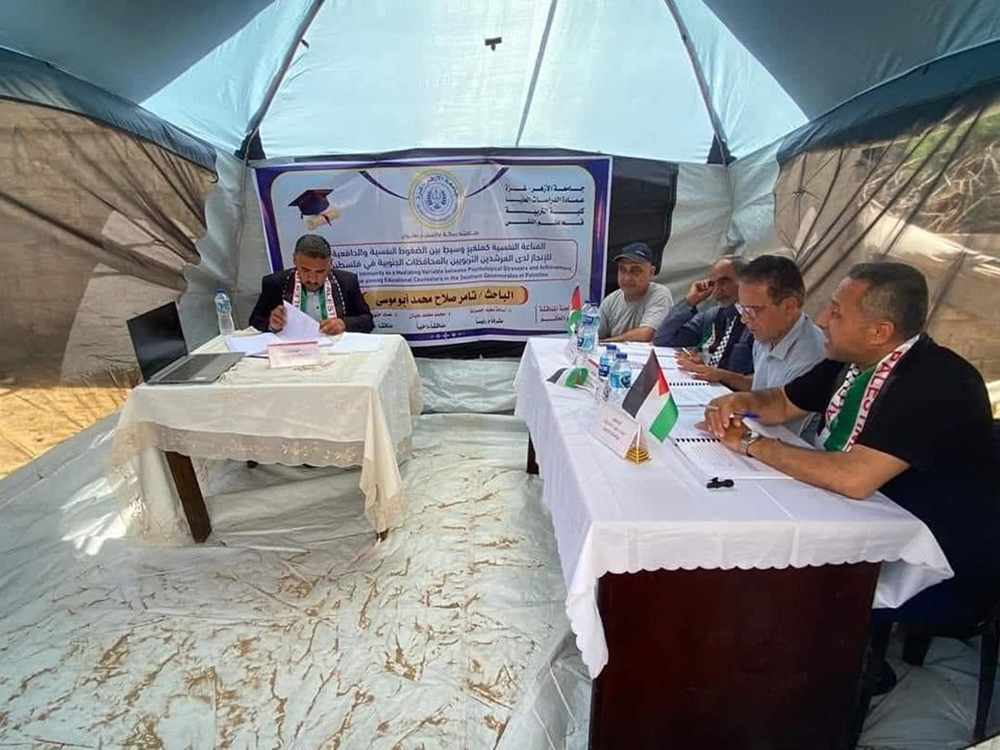 Tamer Salah Abu Mousa, a student at the destroyed Al-Azhar University in Gaza, defends his master's thesis from inside a tent
Tamer Salah Abu Mousa, a student at the destroyed Al-Azhar University in Gaza, defends his master's thesis from inside a tent
Gaza is only 362 square kilometers, and its population is 2.3 million. After the Nakba of 1948, tens of thousands of Palestinians from the villages in the districts of Gaza, Jaffa (Yafa), Ramla, and Beersheba (Be'er el-Saba) sought refuge in Gaza.
In its genocidal war on Gaza, the Israeli war machine has fought to wipe out its humans, homes, and trees, just as it did in 1948, and again in 1967.
The Strip is the most densely populated area on the face of the earth. Homes and institutions such as hospitals, schools, colleges, universities, markets, and stores are all intertwined, actively working together, harmoniously and with determination.
Even before this war, the people of Gaza endured hardship on a daily basis, under a long and bitter siege imposed by the occupation army, which prevented any movement without prior approval.
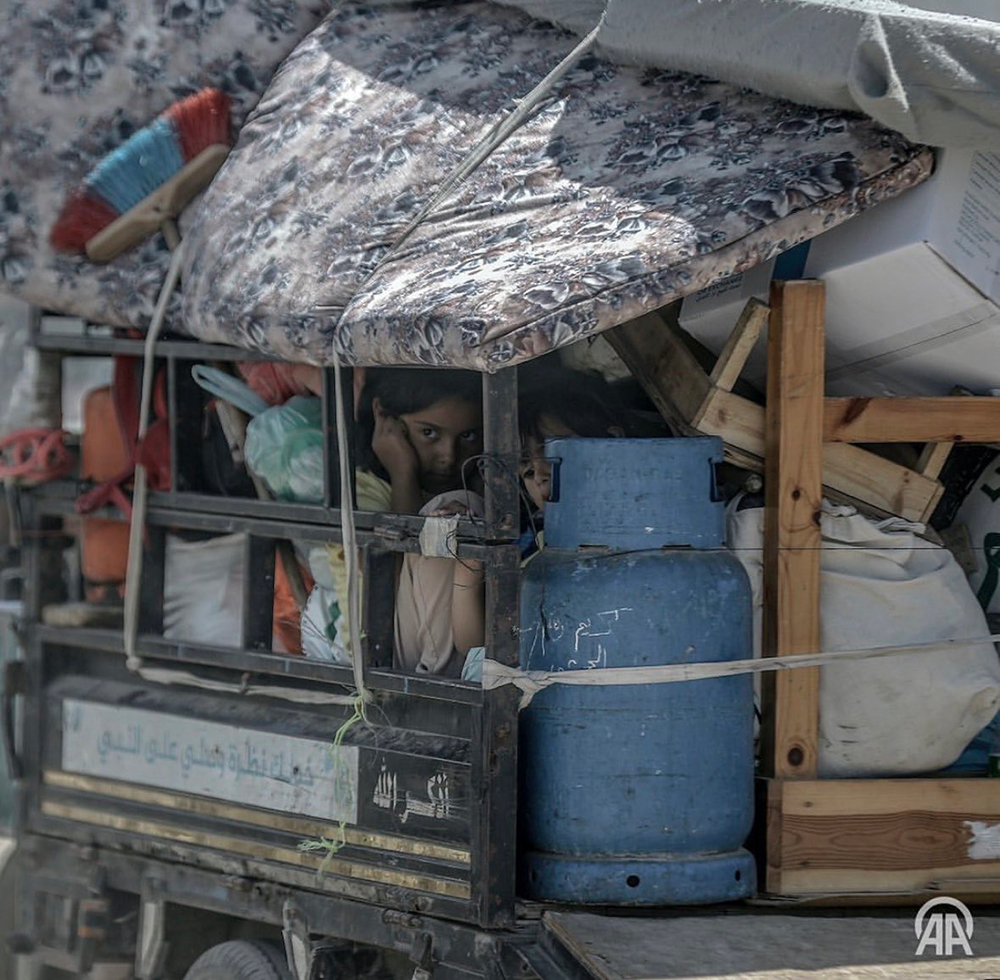 Forced displacement in Gaza — Photo by Ali Jadallah
Forced displacement in Gaza — Photo by Ali Jadallah
This retaliatory war came as part of an operation to eliminate the existence and presence of the Palestinian people, represented by their intellectual, creative, cultural, and heritage institutions.
The war machine began by destroying Gaza’s six universities, blowing up and demolishing their facilities, buildings, laboratories, equipment, and libraries.
Dozens of ancient museums established by Gazans in their family's palaces from centuries past were destroyed, including the Shawwa family home, which was open to the public.
Heritage libraries were also obliterated – libraries previously containing ancient manuscripts, writings, documents, photographs and maps, memorializing the Palestinian legacy.
Gaza, a city born five thousand years ago, is not momentary or transient; it carries a cultural history known through what has been documented by historians, geographers, travelers, archaeologists, and others, along with a collective memory of the place carried by its people through the ages.
Even the ancient mosques and churches in the city, like the Great Omari Mosque and Church of Saint Porphyrius, the third oldest church in the world, were not spared.
Gaza, a city born 5,000 years ago, is not momentary or transient; it carries a cultural history well documented by historians, geographers, travelers, archaeologists, and lives in the collective memory of its people.
To this day, the machine of destruction continues to erase public libraries that once provided scientific, intellectual, and human resources to the people of Gaza, whether for academic purposes or otherwise.
It has destroyed schools, including those under the United Nations Relief and Works Agency (UNRWA), an international entity. These schools turned into shelter sites for displaced Gazans seeking safety.
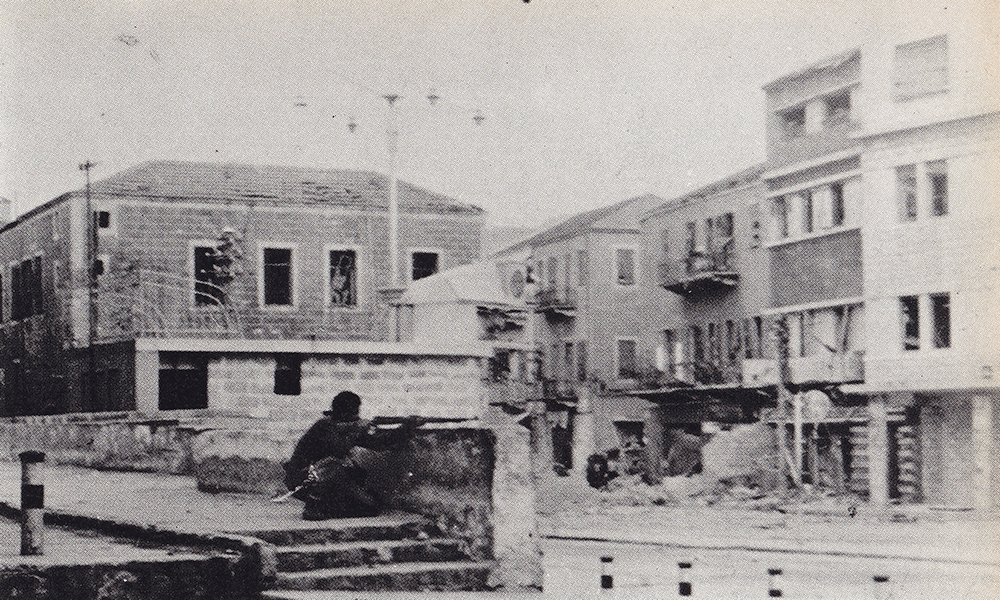 Jewish agents and snipers in the Hanatir Square (Sahat al-Hanatir), Haifa – Archive of historian Johnny Mansour
Jewish agents and snipers in the Hanatir Square (Sahat al-Hanatir), Haifa – Archive of historian Johnny Mansour
This genocidal chapter is hardly unfamiliar. It is just the latest episode of the same act that unfolded during the June War of 1967. At the time, in the Golan, 150 Syrian villages and towns were destroyed, with only five villages remaining.
All were obliterated, including institutions, schools, libraries, and more.
Similarly, in 1948, the year of catastrophe, Zionist military organizations carried out displacement, expulsion, and destruction operations of Palestinians and Palestinian land.
In April 1948, the Haganah Zionist military organization launched a series of military operations in the city of Haifa and other Palestinian cities.
In Haifa, the scene was particularly harsh, as they executed "Operation Scissors", in which Haganah forces attacked the Arab neighborhoods of Wadi Nisnas, al-Halisa, Al-Balad Al-Tahta, the vicinity of the port, and the intersections of the German Quarter with the western side.
 Demolition of houses and shops on Allenby Street, Haifa – Archive of historian Johnny Mansour
Demolition of houses and shops on Allenby Street, Haifa – Archive of historian Johnny Mansour
The Palestinian residents of Haifa's had no choice but to flee, rushing towards the port, where English, and perhaps Arab, ships, boats, and rafts awaited them, transporting them to Acre (Akka), Tyre, and Port Said.
The English helped push the fleeing people towards the port away from the force of the Haganah's bombs and projectiles. This fact has been testified by several elderly people in interviews over the decades.
Another operation was then carried out in Haifa, known as "Passover Cleansing", as it coincided with the Jewish holiday of Passover. According to Jewish tradition, on Passover, household utensils are purified with water and fire, then either returned to their place or replaced entirely. Over the holiday in 1948, 95% of Haifa's original inhabitants were expelled.
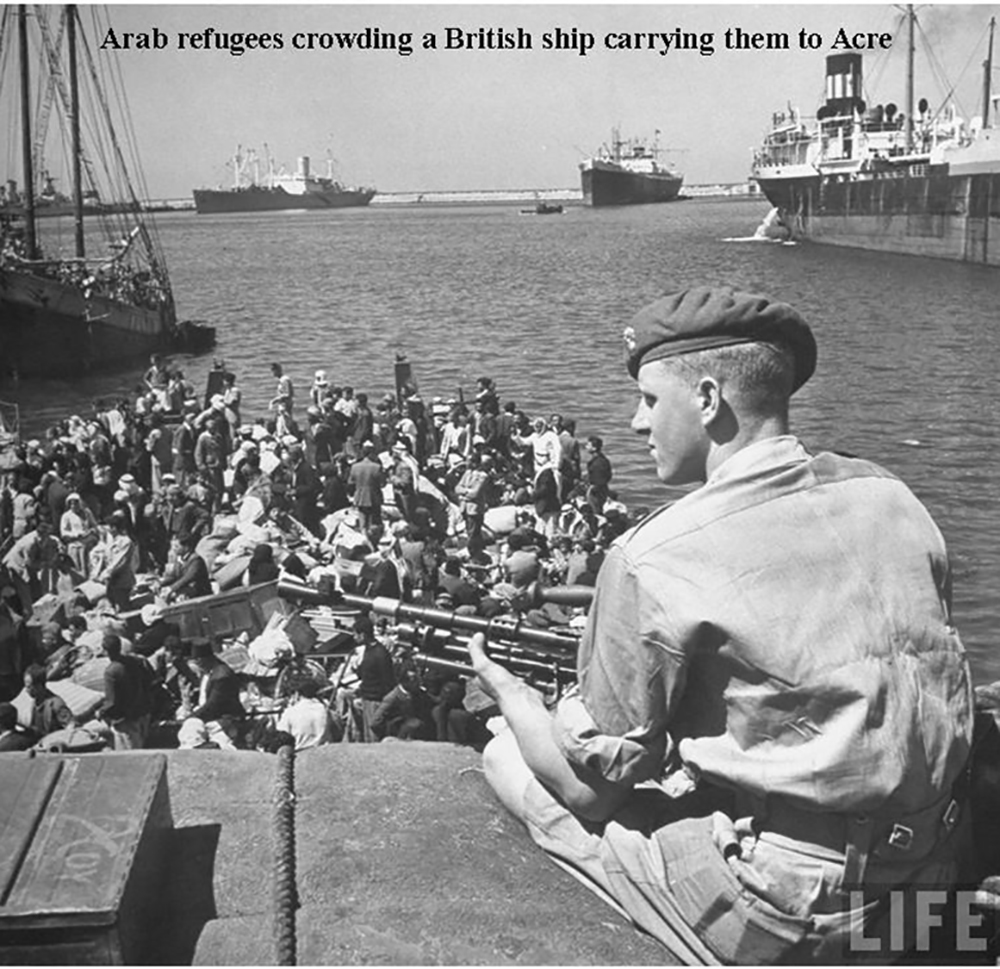 The displacement of Haifa residents to Acre (Akka) on British ships – Life Group Archive
The displacement of Haifa residents to Acre (Akka) on British ships – Life Group Archive
But the operation did not stop there. Parts of the locally significant Frère School, affiliated with one of the city’s churches, were bombed during the attacks on the Arab neighborhoods and main intersections in the city.
Additionally, while standing on the roof of the Salesian School on King George V Avenue, a priest was sniped and killed instantly. In response, the school was shut down.
Haganah militants seized the Islamic Society School in the Burj neighborhood, near the Haifa Municipality building, and turned it into a military barracks. It remains so to this day.
During the demolition of the old part of Haifa, which was built by Sheikh Zahir al-Umar al-Zaydani, the ruler of Galilee in the mid-18th century, Israel's demolition machine, under the supervision of the Mayor of Haifa and government officials, targeted old neighborhoods and markets, including schools and health clinics.
From only a tent left of a university that has been reduced to a pile of rubble, to doing history justice, there is a long road. It seems the Palestinians will walk this path toward achieving their just and rightful dream.
During the Israeli aggression on the old neighborhoods of Haifa, the Greek Orthodox monastery and school adjacent to the old church were bombed and destroyed, without any deterrent or conscience.
Municipal and government institutions went a step farther, by building a main street on the former site of the monastery and school.
Cultural institutions such as cinemas and theaters in the old part of Haifa, the old town, were demolished.
The remaining structures were gradually destroyed over time to make way for residential and commercial towers, erasing all traces of these Palestinian institutions, leaving no memory of them on the ground.
The same machine occupies, destroys, erases, and replaces. It seems programmed to implement modern colonialism, supported intellectually by biblical texts and writings that allow this machine to act without punishment, accountability, or trial. It is well versed in successfully escaping punishment.
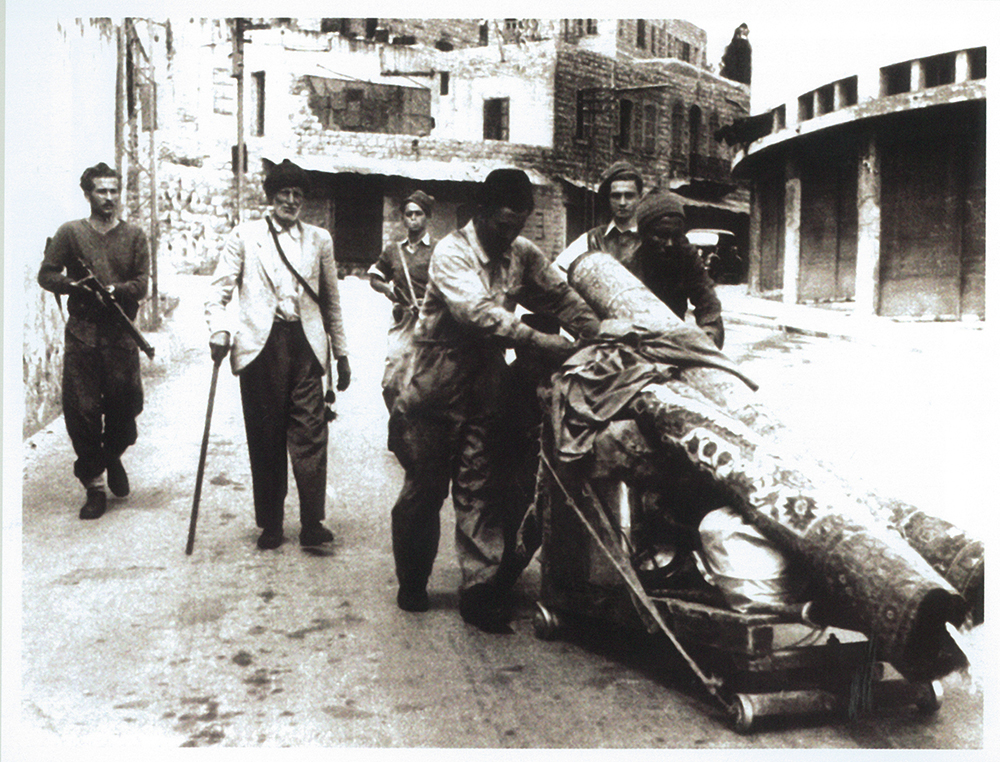 The expulsion of residents from the Wadi Salib neighborhood, Haifa – Archive of historian Johnny Mansour
The expulsion of residents from the Wadi Salib neighborhood, Haifa – Archive of historian Johnny Mansour
The question remains, will the files on this war on Gaza be opened without revisiting the files of 1948? It is in files of 1948 the heart of the issue can be found. How can we imagine millions of Palestinian refugees and displaced persons from 531 villages and cities without history doing them justice?
The minds of every Palestinian, both inside and outside Palestine, are filled with questions. Among them are legitimate questions that we must not overlook at this time – another Nakba.
These questions push us to think about the future of our homeland, our fate, and our land.
The road ahead is long. It seems that the Palestinians will walk the path toward achieving their just and rightful dream of a homeland they deserve, by land, sky, and sea.
* The views and opinions expressed in this article are those of the author’s and do not necessarily reflect the official policy or position of Raseef22
Raseef22 is a not for profit entity. Our focus is on quality journalism. Every contribution to the NasRaseef membership goes directly towards journalism production. We stand independent, not accepting corporate sponsorships, sponsored content or political funding.
Support our mission to keep Raseef22 available to all readers by clicking here!
Interested in writing with us? Check our pitch process here!
